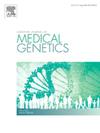Vascular findings in five unrelated children with vascular Ehlers-Danlos syndrome: A multi-case report
IF 1.7
4区 医学
Q3 GENETICS & HEREDITY
引用次数: 0
Abstract
Vascular Ehlers-Danlos syndrome (vEDS) is an inherited connective tissue disorder caused by heterozygous variants in COL3A1, leading to tissue and vessel fragility alongside an increased risk of potentially fatal aneurysms and dissections. Although vascular events most commonly manifest in adulthood, childhood events also occur. Knowledge on clinical manifestations in childhood and potential benefits of vascular surveillance is limited, and no evidence-based guidelines for predictive genetic testing and follow-up exist.
We present five patients diagnosed with vEDS in childhood, focusing on vascular events. The patients receive follow-up at a multidisciplinary heritable thoracic aortic disease clinic at Oslo University Hospital and are registered in the associated patient registry.
Two of the five patients experienced a childhood vascular event, both involving cerebral vessels. In one of these patients, the event may not be vEDS related. A mild aortic root dilatation was detected in one patient. No severe aortic events like dissection or rupture were reported in childhood, but one patient died from an aortic dissection in early adulthood despite normal findings on MRA scans in the years he received regular surveillance.
Our findings highlight the variable expressivity of vEDS, including severe childhood vascular events. Further studies to evaluate the effect of surveillance are needed to form an evidence base for surveillance guidelines in pediatric patients. Established benefits of surveillance and management are essential for deciding on whether and when to perform predictive genetic testing of a child at risk.
5例无血缘关系的儿童血管性埃勒-丹洛斯综合征的血管表现:多病例报告。
血管性埃勒斯-丹洛斯综合征(vEDS)是一种由COL3A1杂合变异引起的遗传性结缔组织疾病,导致组织和血管脆弱,同时增加潜在致命动脉瘤和夹层的风险。虽然血管事件最常见于成年期,但儿童期也会发生。关于儿童时期的临床表现和血管监测的潜在益处的知识是有限的,并且没有基于证据的预测性基因检测和随访指南。我们报告了5例儿童期诊断为vEDS的患者,重点关注血管事件。患者在奥斯陆大学医院的多学科HTAD诊所接受随访,并在相关患者登记处登记。五名患者中有两名经历了儿童血管事件,均涉及脑血管。在这些患者中,事件可能与vEDS无关。在一名患者中发现轻度主动脉根扩张。儿童时期没有严重的主动脉夹层或破裂等事件的报道,但有一名患者在成年早期死于主动脉夹层,尽管在他接受定期监测的几年中,MRA扫描结果正常。我们的研究结果强调了vEDS的可变表达性,包括严重的儿童血管事件。需要进一步的研究来评估监测的效果,以形成儿科患者监测指南的证据基础。监测和管理的既定利益对于决定是否以及何时对处于危险中的儿童进行预测性基因检测至关重要。
本文章由计算机程序翻译,如有差异,请以英文原文为准。
求助全文
约1分钟内获得全文
求助全文
来源期刊
CiteScore
4.10
自引率
0.00%
发文量
193
审稿时长
66 days
期刊介绍:
The European Journal of Medical Genetics (EJMG) is a peer-reviewed journal that publishes articles in English on various aspects of human and medical genetics and of the genetics of experimental models.
Original clinical and experimental research articles, short clinical reports, review articles and letters to the editor are welcome on topics such as :
• Dysmorphology and syndrome delineation
• Molecular genetics and molecular cytogenetics of inherited disorders
• Clinical applications of genomics and nextgen sequencing technologies
• Syndromal cancer genetics
• Behavioral genetics
• Community genetics
• Fetal pathology and prenatal diagnosis
• Genetic counseling.

 求助内容:
求助内容: 应助结果提醒方式:
应助结果提醒方式:


